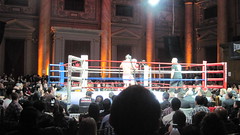A volley of kicks and punches were unleashed as fights broke out on the Bowery on Friday night, but it wasn’t what you think: More than 500 people had descended on the lavish Beaux Arts building that once housed the Bowery Savings Bank to watch “Combat at the Capitale.” Presented by Lou Neglia, a three-time champion of the World Kickboxing Association, the night showcased some of the top kickboxers from gyms in New York City and beyond.
Shortly after 8 p.m., the first of the evening’s 16 scheduled bouts began. Wearing headgear, gloves and shin guards, Rich Schaefer and Nazin Sadykov battled each other for three two-minute rounds, their fists hissing through the air and legs thumping against each other. Fans sipping beer and pricy mixed drinks from hilariously tiny plastic cups shouted for the occasional “uppercut!” and “leg sweep!” in thick New York accents. Mr. Schaefer prevailed over Mr. Sadykov in a close decision, having gained the edge on two out of the three judges’ scorecards.
Almost every bout of the evening was a close one. That was no accident. When gyms contact Mr. Neglia with the fighters they want to put up for a match, he weighs them closely. “I take pride that I make the fights even,” he said during a phone interview on Saturday. He added, “No one wants to watch an uneven fight.”
And he should know. Although he retired from fighting in 1985, Mr. Neglia, now in his late fifties, is an eighth-degree black belt with a career record of 34 wins and two losses. Born and raised in Brooklyn, he founded the Lou Neglia Martial Arts Academy there in 1973 and is the president of Ring of Combat, an event series that pits some of the top professional martial artists against each other in a tournament-style setting.
Mr. Neglia first began promoting kickboxing events in New York City in the early 1990s, at venues like the Copacabana and the Hilton Hotel. Mr. Neglia said that the work ethic he observed during his fighting career helped him ascend as a promoter. “Fighters respect what I have accomplished in the field,” he said. “I have a good rapport with them.”
Mr. Neglia staged the first of 26 events at Capitale in 2003 and currently promotes four kickboxing events there each year. By collecting cash at the gate (tickets for Friday’s event started at $35), securing sponsors, charging vendors and letting paying customers stream the event over the Internet, Mr. Neglia is able to turn a profit despite the high cost of insurance (required by the venue and by the sanctioning body of the event, the World Kickboxing Association) as well as the cost of renting out an events space that usually caters to celebrities like Mick Jagger or the cast of “Sex in the City.”
“You need to have a good business plan and just know what you’re doing,” he said. “If I didn’t make money there the first time, I never would have came back for a second.”
Besides using their fists and their feet, kickboxers can also use their knees and sometimes even their elbows to strike an opponent. The traditional knockdown rules of boxing don’t apply, though the way that rankings are determined and the decisions about who is worthy of a title shot are fairly similar. It basically comes down to win or losses.
One title contender, Julio Arce, got his title shot on Friday night and made the most of it. Challenging Tim Amorim, the W.K.A.’s incumbent Muay Thai champion in the 140-pound class, Mr. Arce was unanimously judged to be the victor after a spirited five-round title bout that capped off the night’s festivities. Representing the Tiger Schulman Mixed Martial Arts Academy in Bayside, Queens, Mr. Acre smiled while being awarded the title belt, and the appreciative crowd cheered him on.




